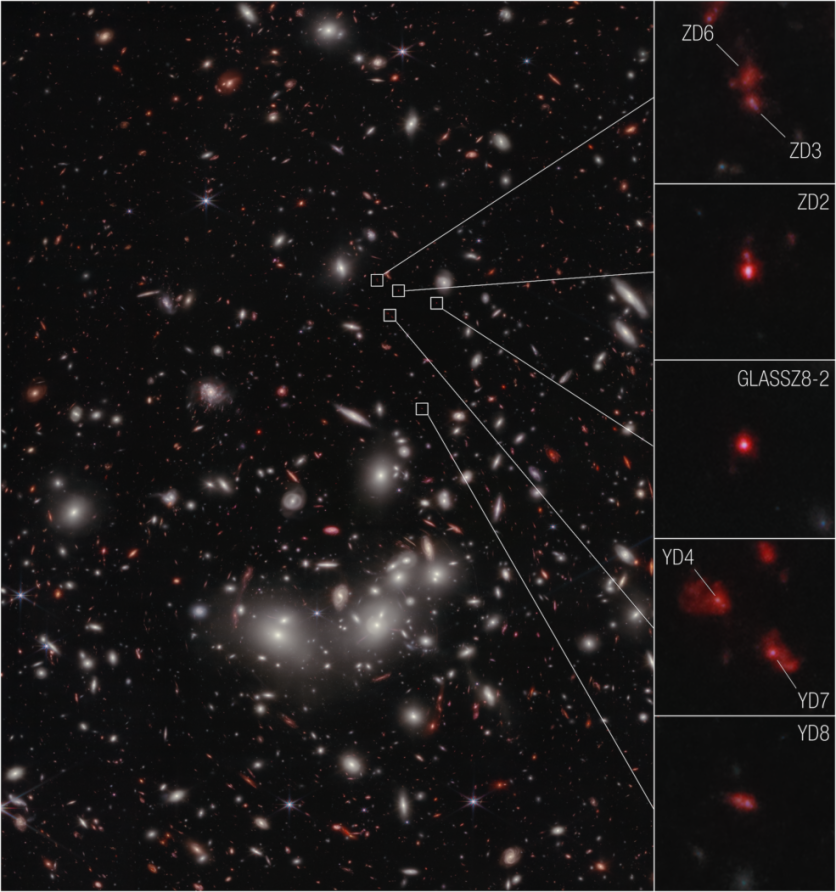NASA's James Webb Space Telescope has captured a breathtaking glimpse into the early universe, revealing the formation and assembly of galaxies previously beyond our reach.
At a distance of redshift 7.9, scientists have confirmed the existence of a protocluster consisting of seven galaxies that is a mere 650 million years old after the big bang.

Unique Site of Galaxy Evolution
"This is a very special, unique site of accelerated galaxy evolution, and Webb gave us the unprecedented ability to measure the velocities of these seven galaxies and confidently confirm that they are bound together in a protocluster," said Takahiro Morishita of IPAC-California Institute of Technology, the lead author of the study.
Using Webb's Near-Infrared Spectrograph (NIRSpec) was instrumental in acquiring accurate measurements and verifying the distance between the galaxies as well as their high velocities, exceeding two million miles per hour (about one thousand kilometers per second), within a halo of dark matter.
The data extracted from the spectrograph enabled astronomers to create models and charts projecting the evolution of this gathering of galaxies until our present time.
The anticipated development of the protocluster is captivating. Astronomers hypothesize that it could resemble the Coma Cluster, which is considered one of the universe's most massive structures.
The Coma Cluster houses thousands of members, making it one of the densest known collections of galaxies. It is a glimpse into the astounding future of the protocluster, akin to observing a seedling grow into a towering plant.
According to NASA, galaxy clusters are the most massive structures that exist in the observable universe. They possess the ability to distort the fabric of spacetime using a phenomenon called gravitational lensing.
Through gravitational lensing, distant objects can be magnified beyond the cluster, giving scientists the ability to peer through the cluster as if using a giant magnifying glass.
The group of researchers used this effect to observe the protocluster through Pandora's Cluster, as even with Webb's advanced instruments, the assistance of nature is required to see such distant objects.
Building on Hubble, Continuing With Roman
Initially identified by the Hubble Space Telescope's Frontier Fields program, the seven galaxies have been confirmed as promising candidates for further investigation by the Webb telescope.
Using gravitational lensing to examine remote galaxies in detail, the Hubble program devoted time to observations. The Webb telescope has taken over the investigation, delving into the galaxies scouted by Hubble and collecting detailed spectroscopic data in addition to images.
The discovery of the protocluster is only the beginning. The results obtained by Webb will serve as a model for future space missions.
NASA's Nancy Grace Roman Space Telescope, a high-resolution, wide-field survey mission, will collaborate with Webb to uncover more about early galaxy clusters. With 200 times Hubble's infrared field of view in a single shot, Roman can identify additional protocluster galaxy candidates, which Webb can investigate to verify with its spectroscopic instruments.
The launch of the Roman mission is planned for May 2027.
The discovery was further detailed in the Astrophysical Journal Letters.
Related Article : NASA's James Webb Space Telescope Spots 'Teeny Tiny Galaxy' With Massive Star Power!

ⓒ 2025 TECHTIMES.com All rights reserved. Do not reproduce without permission.




